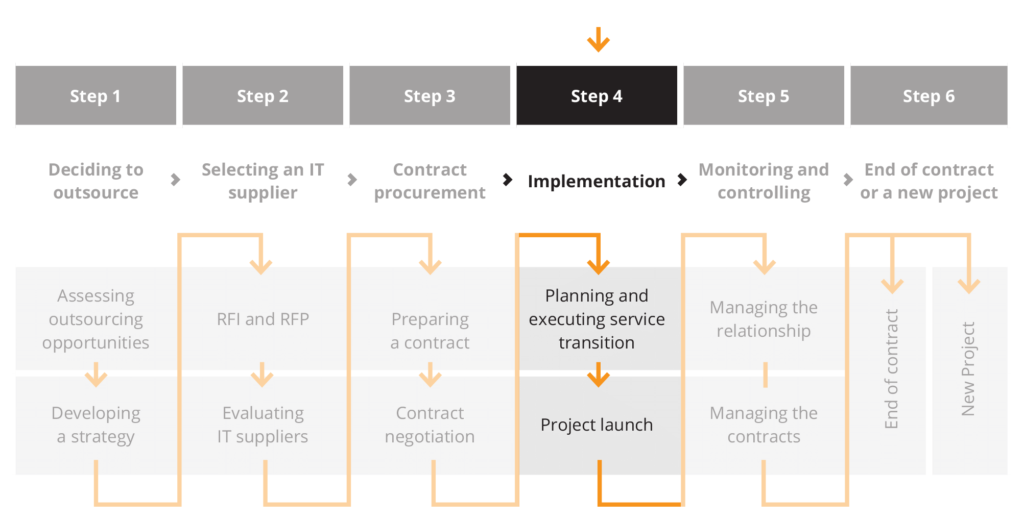Apart from a number of benefits, nearshore outsourcing also involves some risks. Being aware of these risks and taking steps to mitigate them can make the difference between project failure and success.
We have so far covered the IT Outsourcing Risks of the supplier selection and the contracting stages of the outsourcing lifecycle, and this time, we are looking at the implementation stage which includes service transition and project launch. The article will concentrate on the risks of IT service transition.
Step 4: Implementation

IT service transition to a new provider
What is IT service transition?
Service transition can be defined as the implementation of a new way of operating by handling over the services from an old team to a new team with an aim of achieving operational performance. The old team may either be the client or an outgoing service provider whom the client decided to replace with a new team – usually another provider or, in case of backsourcing, the client again.
This article will focus on the scenario whereby the transition takes place between the client and an IT outsourcing service provider.
An IT service transition requires careful planning to ensure it is conducted with minimum disruption to your business and customers. Its success is dependant on your ability of identifying and mitigating the risks. The CIO magazine found that at least two-thirds of outsourcing remediation cases can be traced back to the problems of the transfer or transition stage. When the transition involves the handover of services to the new provider it defines the relationship with this new provider.
The risks of IT service transition
What are the risks involved IT service transition? Poor service transition can be detrimental not only to the services that are to be transferred, but also to your entire business. It can affect the relationships you have with your clients, partners and employees and the way they perceive you.
While certain transition risks are more common, there may be a number of additional threats that are specific to your particular sector, business or project.
Here are 10 common risks of IT service transition:
Risk 1: Inadequate knowledge transfer, or shortfall in knowledge or skills
Knowledge transfer is a huge risk in any transition. As you move your services to a provider, there is a risk of your company not giving them all the information they require for the transition to take place and for the services to operate smoothly. At times, the management is not aware of the operational nitty-gritty and certain gaps in knowledge may surface later.
Additionally, you may also have to deal with your own staff’s unwillingness to share as they are being replaced. Similarly, if switching between IT service suppliers, the outgoing supplier may not be willing to share the knowledge with their competition.
There is also a risk of your new supplier not having access to certain skills which may be in high demand.
Risk 2: Gaps in documentation
The risk of inadequate documentation is connected to the knowledge transfer. During transition, you may find out that some of the internal documentation is out-of-date, incomplete or even non-existent.
Risk 3: Lack of access to systems or inadequate system permissions
If not catered for earlier, inadequate access to systems or insufficient permissions can be an unwelcome surprise and an enormous hindrance when things need moving quickly.
Risk 4: Partial or full interruption of service
Service downtime, even when temporary, may seriously damage the relationships with your stakeholders who require availability and reliability of your services.
Risk 5: Degradation of service quality
The quality of service degradation is yet another risk which impacts the way your stakeholders view your services. It is therefore important to aim for the same (or better) level of quality that existed prior to the transition.
Risk 6: Lack of harmonisation of processes
The risk of poor integration of processes between you and the supplier may cause inefficiency, extra work hours and the effect of working in silos.
Risk 7: Project delays
As with any project, schedule delays often mean increased costs. However, with such large projects as service transitions, delays are not uncommon.
Risk 8: Additional costs
During transition, additional costs may come from a number of sides – e.g. as a result of poor work planning, or due to an overly risk-averse plan, because of interruptions of service or the loss of work hours.
Risk 9: Alienation and demotivation of your own employees
Changes to responsibilities, job roles, practices and processes which result from service transition may de-motivate and frustrate your own workforce leading to resistance to change and unwillingness towards passing their knowledge to the new team.
Risk 10: Miscommunication and cultural misunderstandings
The risk of miscommunication can occur in any circumstances, however, with misunderstandings resulting from cultural differences, they are more likely to happen the further the culture is from your own.
CONCLUSION
IT service transition is a complex process and a delicate operation which involves plenty of risks. The awareness of these risks is, however, the first step towards a successful project launch and, further, the success of the entire transition. The next thing that needs to be done to bring the success closer, is to take appropriate action to mitigate these risks.
To find out how to deal with the risks of IT service transition, download the Mitigating IT Outsourcing Risks: Part III – Implementation guide.
The guide will provide concrete actions which you can take in order to mitigate the 10 risks of IT service transition we list above.
Sources:
Letourneau, R. 2015 Top 5 transition risks and how to mitigate them available at http://thinkwgroup.com/top-5-transition-risks-and-how-to-mitigate-them-2
Olzmann, M. and Wynn, M. 2012, How to Switch IT Service Providers: Recommendations for a Successful Transition, International Journal on Advances in Intelligent Systems, vol 5 no 1 & 2
